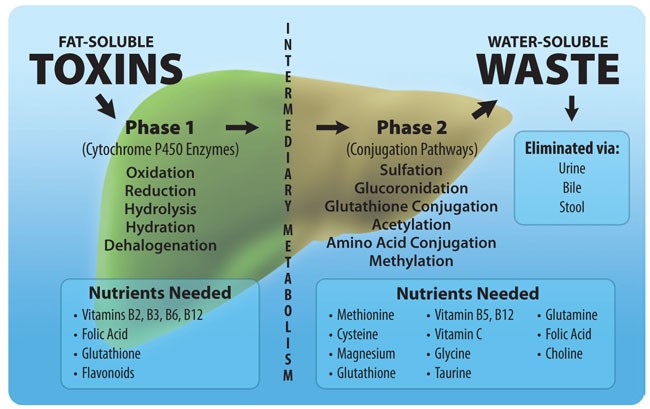Your liver is a workhorse. The work of detoxification is happening everyday, whether you’re “on a cleanse” or not. The liver’s detoxification process is complex, but most simply is divided into two steps, aptly named Phase 1 and Phase 2. This infographic found on www.integrativefamilypractice.com shows an overview of how the liver works.
Pathways and Nutrients:
Phase 1 Detoxification:
The purpose of Phase 1 is to reduce toxicity of chemicals. This process occurs via a special set of enzymes, called Cytochrome P450. Antioxidants is very important for this phase, to neutralize toxic metabolites as chemicals are broken down.
Slow Phase 1 detoxification may occur due to lack of blood flow, sometimes a result of aging or low physical activity. It can also run slow due to deficiency in vitamin and mineral cofactors needed for enzyme function (like riboflavin, niacin, magnesium, and iron). Heavy metal toxicity is especially damaging to this phase.
Extra fast Phase 1 detox can be problematic as well, especially if Phase 2 is slow; in this case, antioxidants become overtaxed and may cause oxidative damage and/or chemical sensitivity.
Phase 2 Detoxification:
Toxins processed through Phase 1 continue to Phase 2, called conjugation, where a side group is added to improve the body’s ability to eliminate the toxin. There are six main pathways in Phase 2, and some chemicals can be detoxed through more than one.
- The Sulfation Pathway: detoxifies bacterial toxins, Tylenol, BPA, sex hormones, thyroid hormones, neurotransmitters, and xenoestrogens (estrogen-like chemicals).
- The Glucuronidation Pathway: detoxifies medications like aspirin, food additives like benzoates and preservatives, and some steroid hormones.
- The Glutathione Transferase Pathway: detoxifies heavy metals, solvents, and pesticides.
- The Acetylation Pathway: detoxifies histamine, serotonin, salicylic acid, tobacco, and car exhaust.
- The Amino Acid Conjugation Pathway: detoxifies toluene (a solvent), benzoate (a food preservative) and other environmental chemicals.
- The Methylation Pathway: detoxifies hormones, neurotransmitters, or toxins, by making them water soluble; detoxifies amines (serotonin, melatonin, histamine, tyramine, and all of the catecholamines: dopamine, norepinephrine, epinephrine), phenols (salicylic acid—aspirin, cannabinoids, estradiol, and BPA), and many other chemicals. Genetic mutations in the methylation cycle can cause mental/emotional imbalance, migraines, hormone imbalance, and toxicity.
Important cofactors throughout Phase 2 include B vitamins, especially methylated versions of folate and B12, trace minerals such as iron, manganese, and molybdenum, amino acids like choline, cysteine, methionine, taurine, and others, like magnesium and vitamin C.
Summary:
Liver detoxification is complex! Be cautious about signing up for just any “detox” plan, because it’s very important to keep the liver and all it’s pathways in sync. A great detox takes the individual and symptoms into consideration. If you are interested in trying a detox, working with a Naturopathic Doctor can enhance your results. I’d love to help you choose the solution that’s right for you. Contact me at Boise Natural Health Clinic for your spring detox!
https://www.integrativefamilypractice.com/blog/liver-detoxification

